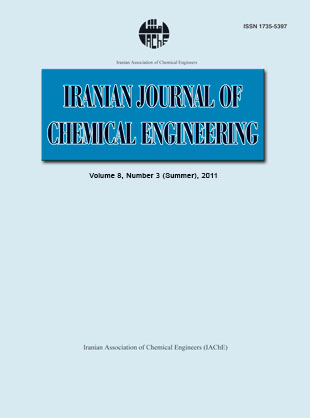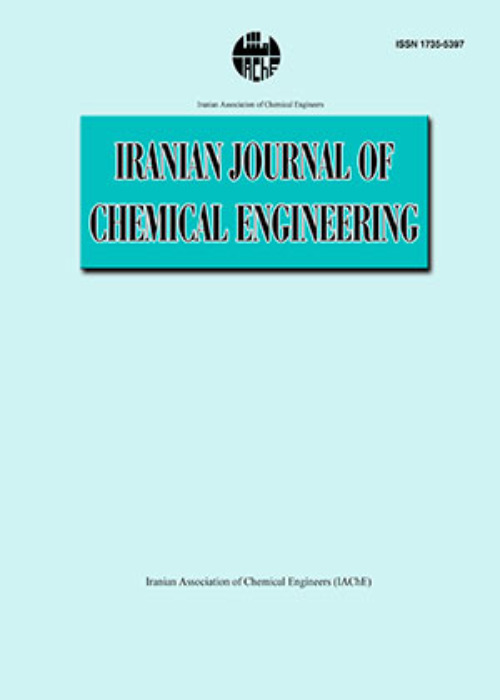فهرست مطالب

Iranian journal of chemical engineering
Volume:8 Issue: 3, Summer 2011
- تاریخ انتشار: 1390/10/06
- تعداد عناوین: 7
-
-
Page 3Monte Carlo simulation is adopted to study the aggregation of asphaltene phenomenon in crude oil. Simulation is accomplished by applying two different potential functions to allow for asphaltene-asphaltene, asphaltene- resin and resin-resin interactions to take place. Asphaltene molecule is considered as a flat molecule, consisting of seven spheres. Resin molecule is considered to be a single sphere and the other hydrocarbons molecules contained in crude oil are modeled as a continuum media. The effect of media on intermolecular interactions is described by definition of a parameter that is composed of two dielectric and Hamaker constants. The effects of asphaltene concentration, temperature and solvent type on the aggregation of asphaltene molecules are investigated by applying both of the potential functions. The predicted results are compared.
-
Page 16Due to existing inhibitors in capable hydrate forming mixture, extra intermolecular interactions affect hydrate formation conditions. Predicting hydrate formation conditions is not possible without considering these interactions. In this work, two different equations of state (EOS) are used and compared to predict the hydrate formation pressure in the presence of inhibitors. The EOSs applied are Elliout-Suresh-Donohue (ESD) EOS and Peng-Robinson (PR) EOS with Wong-Sandler (WS) mixing rules. Parrish and Prausnitz hydrate formation algorithm is coupled with flash calculations to predict hydrate formation pressure at different temperatures and different concentrations of polar inhibitors. Pure and binary interaction parameters are obtained for ESD EOS. On the other hand, necessary unknown parameters which should be used in applying PR with WS mixing rules are adjusted on experimental hydrate formation condition data. Number of water hydrogen bonding sites, which are used in calculations, is also determined. Hydrate formation pressure for different polar inhibitors (methanol, ethanol, 1-propanol, ethylene glycol and diethylene glycol) in various concentrations is predicted with applying the two EOSs. To investigate the ability of the ESD EOS in predicting gas mixture hydrate formation conditions, four different gas mixtures are considered in the absence and presence of hydrate inhibitor. Generally, ESD EOS shows better results in comparison with PR EOS + WS mixing rule.
-
Page 31The effect of cobalt naphthenate and 2-benzoylbenzoic acid on UV-photooxidative degradation of low density polyethylene have been studied. Sheets of these samples were prepared from polyethylene and different concentrations of cobalt naphthenate and 2-benzoylbenzoic acid then these samples were UV-irradiated. Changes in the carbonyl index, tensile strength, elongation at break, crystallinity and density were measured to monitor the degradation. The measurements were done before and after UV-irradiation at every 30-day interval for 90 days. The results show that the UV-irradiation affects the rate of degradation of LDPE with increasing the concentration of the cobalt naphthenate and 2-benzoylbenzoic acid. The increasing rate of degradation is more obvious for the increased concentration of cobalt naphthenate and also the time of irradiation, but the rate of degradation is decreased by incorporation of 2-benzoylbenzoic acid.
-
Page 43Filter cakes obtained in the conventional acid leaching of zinc concentrate are considered a major secondary source for zinc. Solvent extraction may be utilized for the selective separation of zinc from other elements in hydrometallurgical processing of such resources. In the present work, extraction of zinc from the solution obtained from sulfuric acid leaching of cold purification filter cake of Angouran concentrate were performed by using D2EHPA as the extractant. The effects of extractant concentration diluted in Kerosene, solution pH and phase ratio (O:A) were investigated and their optimized values were obtained to be 40 vol.%, 2.5-3 and 4:1, respectively. Under these conditions, 98.8% of Zn could be extracted.
-
Page 48The effect of the addition of different promoters, namely, La, Ir, Re and Cs to trimetallic Pt-Sn-K/Al2O3 catalyst on its performance in propane dehydrogenation was studied. The reference trimetallic Pt/Sn/K and tetrametallic catalysts Pt/La/Sn/K, Pt/Ir/Sn/K, Pt/Re/Sn/K and Pt/Sn/Cs/K were prepared by sequential impregnation of γ-alumina support. The catalysts were characterized by TPD and TPR tests. Catalytic performance tests were carried out in a fixed-bed quartz reactor for propane dehydrogenation activity and propylene selectivity under representative industrial conditions. The Pt/Sn/Cs/K catalyst showed better performances in terms of propylene yield. The performance of Pt/Sn/Cs/K catalysts was further improved by adjusting its Cs loading. The addition of Cs to Pt-Sn-K/Al2O3 catalyst could improve catalytic performance chiefly through modifying the nature of acidic function of the support.
-
Page 55In this paper, the droplet size distribution of the Tehran refinery crude oil/water emulsions is determined by analyzing the photomicrographs of model emulsions which were taken by microscope. The normal distribution function is fitted to the experimental data in order to reproduce the droplet size distribution (DSD) of the emulsions by using mean diameter and standard deviation. The effect of different parameters such as surfactant concentration, salinity, and the power of homogenizer on the droplet size distribution and mean droplet diameter of the emulsions are determined. The smaller droplet size was observed in high concentrations of surfactant and in the absence of salt, and also in emulsions which were prepared with lower power of homogenizer.
-
Page 64Accurate crude oil measurement at the metering station is one of main aims in an oil export terminal. The main objective is to decrease or remove any error at the metering station. It is found that crude oil temperature at metering station has significant effects on measured volume and may cause big uncertainty at the metering point, as crude oil flows through the pipeline pick up the solar radiation and heat up. This causes the crude oil temperature at the metering point to rise and higher uncertainty to be created. The amount of temperature rise depends on the main pipeline flow rate. In Kharg Island, there is about a 3 km distance between crude oil storage tanks and the metering point. The crude oil flows through the pipeline due to gravity effects as storage tanks are located 60m higher than the metering point. The flow rate could be controlled by the appropriate valves. In this study, based on the climate and geographical conditions of Kharg Island, the temperature at the metering point has been calculated and the effects of main pipe line flow rate have been investigated. Further, the uncertainty in the measurement system due to temperature rise has been studied.


